 presents a T5 tube light of 150 cm long emitting a neutral white light. The T5 tube sits inside a wider transparent tube that protects the T5 tube. Inside this protection tube there is a reflector, sitting behind the T5 tube and filling the outer tube for half. This T5 tube is connected directly to the 230 V grid voltage.
presents a T5 tube light of 150 cm long emitting a neutral white light. The T5 tube sits inside a wider transparent tube that protects the T5 tube. Inside this protection tube there is a reflector, sitting behind the T5 tube and filling the outer tube for half. This T5 tube is connected directly to the 230 V grid voltage.
This article shows the measurement results. Many parameters are also found in the Eulumdat file.
See this overview for a comparison with other light bulbs.
Summary measurement data
| parameter | meas. result | remark |
|---|---|---|
| Color temperature | 4132 K | Neutral white |
| Luminous intensity Iv | 517 Cd | Measured straight underneath the lamp. |
| Illuminance modulation index | 24 % | Measured straight underneath the lamp. Is a measure for the amount of flickering. |
| Beam angle | 161 deg | 161º for the C0-C180 plane (crossing length direction of the tube) and 112º for the C90-C270 plane (length direction). |
| Power P | 28.6 W | |
| Power Factor | 0.96 | For every 1 kWh net power consumed, there has been 0.3 kVAhr for reactive power. |
| THD | 22 % | Total Harmonic Distortion |
| Luminous flux | 2123 Lm | |
| Luminous efficacy | 74 Lm/W | |
| EU-label classification | A | The energy class, from A (more efficient) to G (least efficient). |
| CRI_Ra | 82 | Color Rendering Index. |
| Coordinates chromaticity diagram | x=0.3783 and y=0.3875 | |
| Fitting | FL-tube | This Tube Light is connected directly to the 230 V grid voltage. |
| PAR-value | 4.2 μMol/s/m2 | The number of photons seen by an average plant when it is lit by the light of this light bulb. Value valid at 1 m distance from light bulb. |
| PAR-photon efficacy | 0.6 μMol/s/We | The toal emitted number of photons by this light, divided by its consumption in W. It indicates a kind of efficacy in generating photons. |
| S/P ratio | 1.6 | This factor indicates the amount of times more efficient the light of this light bulb is perceived under scotopic circumstances (ow environmental light level). |
| L x D external dimensions | 1499 x 35 mm | External dimensions of the lamp (L = length, without the pins). |
| L x W x H luminous area | 1410 x 30 x 8 mm | Dimensions of the luminous area (used in Eulumdat file). The height is equal to the surface of the T5 tube coming above the reflector. The width and the length is equal to the width and length of the frontal opening of the reflector. |
| General remarks | The ambient temperature during the whole set of measurements was 23.5-25 deg C. The temperature of the lamp gets about 14 degrees hotter than ambient. The end caps in which the power supply is integrated become hotter, max 34 degrees higher than ambient. Warm up effect: during the warm up time the illuminance increases until 220 %. Voltage dependency: the power consumption and illuminance vary linarly when the voltage is varied from 200 – 250 V. |
|
| Measurement report (PDF) | ||
| Eulumdat file |  |
Right click on icon and save the file. |
Overview table
The overview table is explained on the OliNo website. Please note that this overview table makes use of calculations, use this data with care as explained on the OliNo site. E (lux) values are not accurate, when within 5 x 1410 mm ≈ 7100 mm. Within this distance from the lamp, the measured lux values willl be less than the computed values in this overview as the measurements are then within the near field of the lamp.
EU Energy label classfication
With the measurement results of the luminous flux and the consumed power the classification on energy of this lamp is calculated. This information is requested in the EU for certain household lamps, see also the OliNo site that explains for which lamps it is requested, how the label looks like and what information it needs to contain.
Herewith the labels for this lamp in color and black and white.
EU energy label of this lamp
Label in black and white.
Eulumdat light diagram
This light diagram below comes from the program Qlumedit, that extracts these diagrams from an Eulumdat file. It is explained on the OliNo site.
The light diagram giving the radiation pattern.
It indicates the luminous intensity around the light bulb. The plane C0-C180 (crossing the length direction) has a wider beam than the C90-C270 (along the length direction).
Illuminance Ev at 1 m distance, or luminous intensity Iv
Herewith the plot of the averaged luminous intensity Iv as a function of the inclination angle with the light bulb.
The radiation pattern of the light bulb.
This radiation pattern is the average of the light output of the light diagram given earlier. Also, in this graph the luminous intensity is given in Cd.
These averaged values are used (later) to compute the lumen output.
Intensity data of every measured turn angle at each inclination angle.
This plot shows per inclination angle the intensity measurement results for each turn angle at that inclination angle. There normally are differences in illuminance values for different turn angles. However for further calculations the averaged values will be used.
When using the average values per inclination angle, the beam angle can be computed, being 161º for the C0-C180 plane (crossing the length direction) and 112º in the C90-C270 plane (along the length direction).
Luminous flux
With the averaged illuminance data at 1 m distance, taken from the graph showing the averaged radiation pattern, it is possible to compute the luminous flux.
The result of this computation for this light spot is a luminous flux of 2123 Lm.
Luminous efficacy
The luminous flux being 2123 Lm, and the power of the light bulb being 28.6 W, yields a luminous efficacy of 74 Lm/W.
Electrical properties
A power factor of 0.96 means that for every 1 kWh net power consumed, a reactive component of 0.3 kVAr was needed.
| Lamp voltage | 230 VAC |
| Lamp current | 129 mA |
| Power P | 28.6 W |
| Apparent power S | 29.7 VA |
| Power factor | 0.96 |
Of this light bulb the voltage across ad the resulting current through it are measured and graphed. See the OliNo site how this is obtained.
Voltage across and current through the lightbulb
This waveforms have been checked on requirements posed by the norm IEC 61000-3-2:2006 (including up to A2:2009). See also the explanation on the OliNo website.
Harmonics in in the current waveform and checked against IEC61000-3-2:2006
There are limits for the harmonics for lighting equipment > 25 W. These limits are not met. However this measurement is only an indication, as the voltage used for the lamp is not according to the requirements for this test.
The used voltage has higher harmonic content than what is required for the IEC test.
The Total Harmonic Distortion of the current is computed as 22 %.
Temperature measurements lamp
Temperature image (overview) of the light bulb. Looking for the hottest spots
Hottest spot on the tube, measured on masking tape
| status lamp | > 2 hours on |
| ambient temperature | 24 deg C |
| reflected background temperature | 24 deg C |
| camera | Flir BCAM |
| emissivity | 0.95(1) |
| measurement distance | 0.3 m (tube) and 0.2 m (ends) |
| IFOVgeometric | 1.1 – 0.7 mm |
| NETD (thermal sensitivity) | 100 mK |
(1) The emissivity is set at 0.95 which is close to the value of the masking tape that was used.
The hottest temperature on the tube is about warm-to-the-touch. The tube ends in which the power supply is present get hotter.
Color temperature and Spectral power distribution
The spectral power distribution of this light bulb, energies on y-axis valid at 1 m distance.
The measured color temperature is about 4150 K which is neutral white.
This color temperature is measured straight underneath the light bulb. Below a graph showing the color temperature for different inclination angles.
Color temperature as a function of inclination angle.
The measurement of CCT is measured for inclination angles up to 65º and beyond the illuminance value gets very low (< 5 lux).
The beam angle for the C0-C180 plane is 161º, meaning a 80.5º inclination angle. In this area most of the light is present. The variation in correlated color temperature in this area is less than 1 %.
Looking at the C90-C270 plane the beam angle is 112º, meaning a 56º inclination angle. Here the variation in (correlated) color temperature is about 1 %.
PAR value and PAR spectrum
To make a statement how well the light of this light bulb is for growing plants, the PAR-area needs to be determined. See the OliNo website how this all is determined and the explanation of the graph.
The photon spectrum, then the sensitivity curve and as result the final PAR spectrum of the light of this light bulb
| parameter | value | unit |
|---|---|---|
| PAR-number | 4.2 | μMol/s/m² |
| PAR-photon current | 17.1 | μMol/s |
| PAR-photon efficacy | 0.6 | μMol/s/W |
The PAR efficiency is 62 % (valid for the PAR wave length range of 400 – 700 nm). So maximally 62 % of the total of photons in the light is effectively used by the average plant (since the plant might not take 100 % of the photons at the frequency where its relative sensitivity is 100 %).
S/P ratio
The S/P ratio and measurement is explained on the OliNo website. Here the results are given.
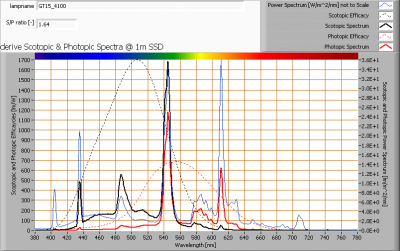
The power spectrum, sensitivity curves and resulting scotopic and photopic spectra (spectra energy content defined at 1 m distance).
The S/P ratio is 1.6.
More info on S/P ratio can be found on the OliNo website.
Chromaticity diagram
The chromaticity space and the position of the lamp’s color coordinates in it.
The light coming from this lamp is at the border of the area designated with class A. This class A is an area that is defined for signal lamps, see also the OliNo website.
Its coordinates are x=0.3783 and y=0.3875.
Color Rendering Index (CRI) or also Ra
Herewith the image showing the CRI as well as how well different colors are represented (rendered). The higher the number, the better the resemblance with the color when a black body radiator would have been used (the sun, or an incandescent lamp). Practical information and also some critics about the CRI can be found on the OliNo website.
Each color has an index Rx, and the first 8 indexes (R1 .. R8) are averaged to compute the Ra which is equivalent to the CRI.
CRI of the light of this lightbulb.
The value of 82 is higher than 80 which is considered a minimum value for indoor usage.
Note: the chromaticity difference is 0.0031 indicates the distance to the Planckian Locus. There is no norm yet that states what the max deviation from white light is allowed to be. A reference with signal lights as a reference is given in the chromaticity diagram.
Voltage dependency
The dependency of a number of lamp parameters on the lamp voltage is determined. For this, the lamp voltage has been varied and its effect on the following light bulb parameters measured: illuminance E_v [lx], the lamppower P [W] and the luminous efficacy [Lm/W].
Lamp voltage dependencies of certain light bulb parameters, where the value at 230 V is taken as 100 %.
The illuminance and consumed power vary linearly when the voltage is varied.
When the voltage at 230 V varies with + and – 5 V, then the illuminance varies ≈ 2 %, so when abrupt voltage changes occur this effect is not visible in the illuminance output.
Warm up effects
After switch on of a cold lamp, the effect of heating up of the lamp is measured on illuminance E_v [lx], the lamppower P [W] and the luminous efficacy [lm/W].
Effect of warming up on different light bulb parameters. At top the 100 % level is put at begin, and at bottom at the end.
The warm up time is about 5-10 minutes. During that time the illuminance increases to 220 % of its initial value.
Measure of flickering
An analysis is done on the measure of flickering of the light output by this light bulb. See for more explanation of the background and measurement setup the explanation articles on OliNo.
The measure of fast illuminance variartion of the light of the light bulb
| parameter | waarde | eenheid |
|---|---|---|
| Flicker frequency | 100 | Hz |
| Illuminance modulation index | 24 | % |
The illuminance modulation index is computed as: (max_Ev – min_Ev) / (max_Ev + min_Ev).
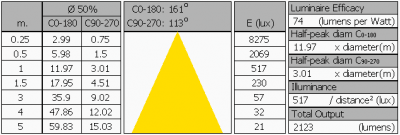
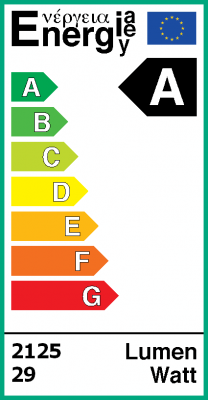

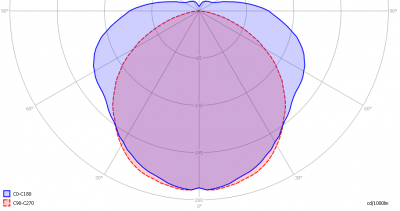
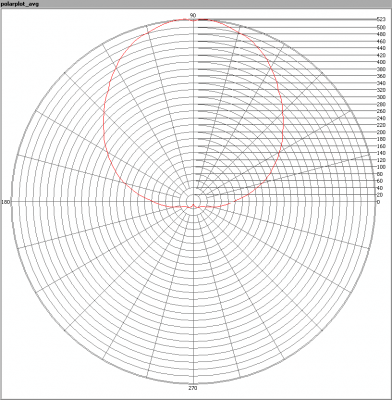

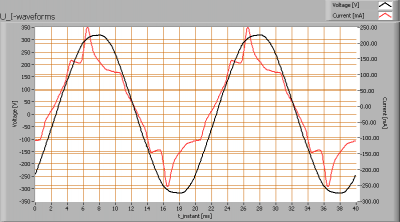
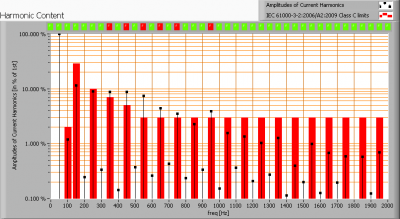
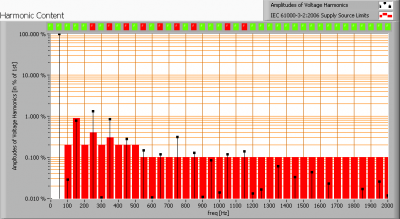
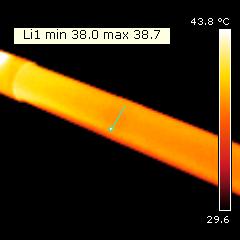
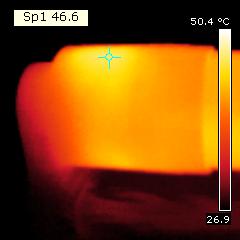
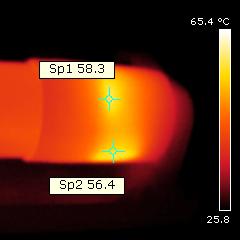
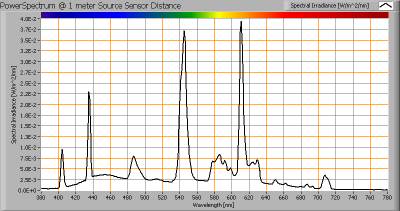
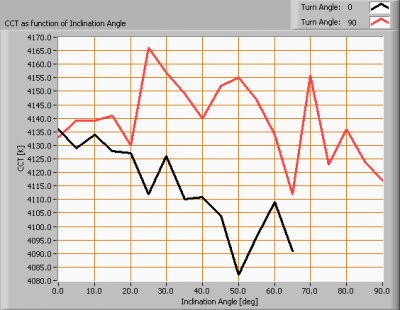
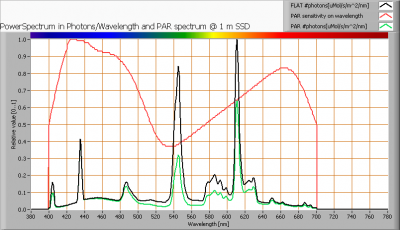
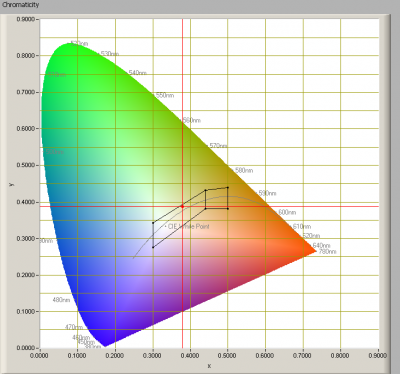
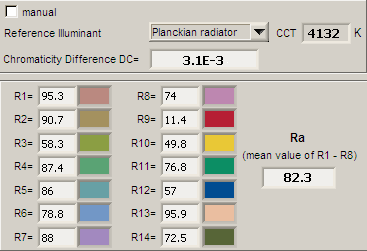
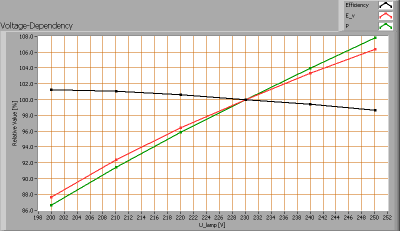
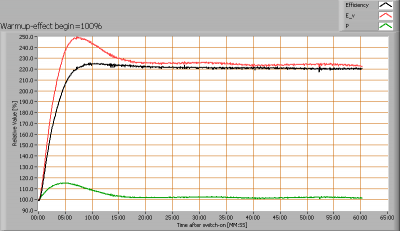
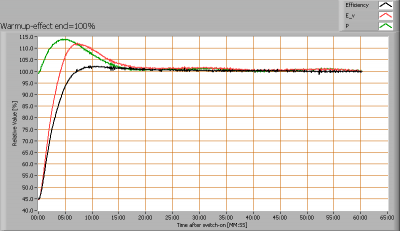
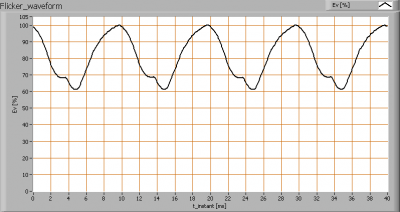





1 reply on “GreenTubes GT15/4100.”
Wat een onzin, een TL buis met een spiegeltje. Ja, dan meet ik ook twee keer zoveel zonlicht met maar een zon. Dus als ik de TL buis in een spiegel armatuur stop is het “voordeel” weg. Toegegeven, zo kun je ook geld verdienen.